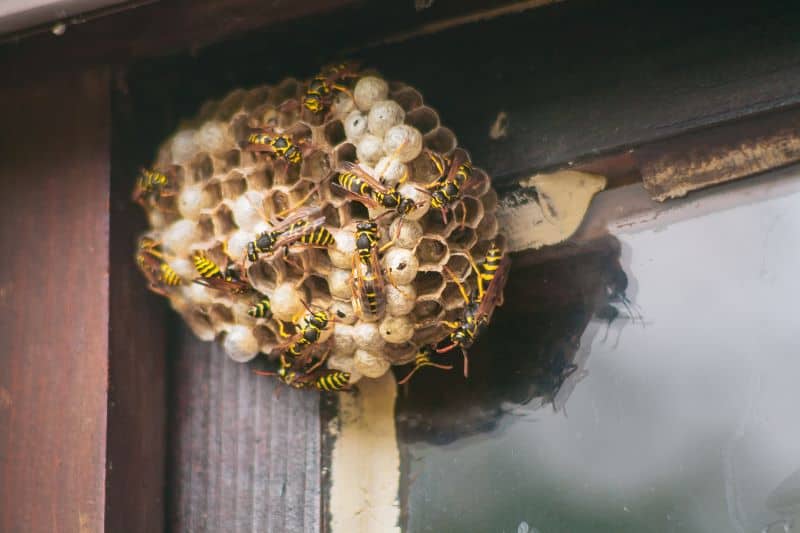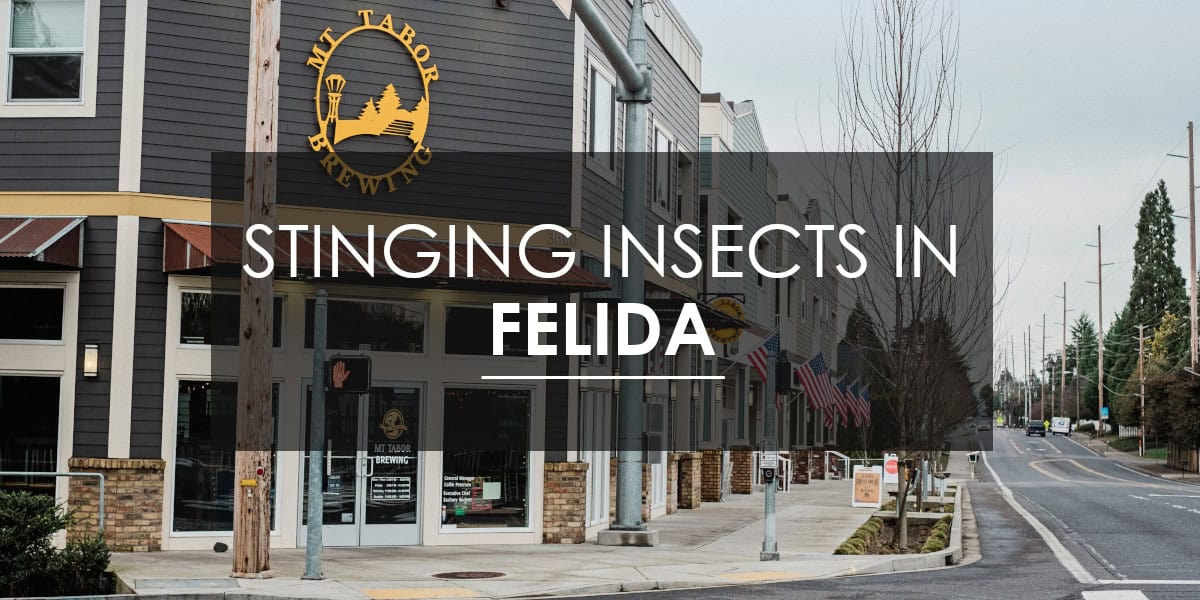If you’re a resident of Felida, WA, or its surrounding areas, you’re likely no stranger to the buzzing presence of stinging insects during the warmer months. From Western Yellowjackets to Bald-faced Hornets and everything in between, these buzzing creatures can pose a significant nuisance and, in some cases, a danger to you, your family, and your pets.
However, rest assured, in this comprehensive guide, we’ll equip you with the knowledge and strategies you need to take control of your stinging insect situation and reclaim your outdoor spaces. Whether you’re dealing with a persistent nest on your property or simply looking to safeguard against potential infestations, we’ve got you covered.
Throughout this article, we’ll delve into the fascinating world of stinging insects, from their identification and nesting habits to the dangers they pose and the most effective methods to eradicate stinging insects. We aim to empower you with the tools and insights necessary to confidently navigate the world of stinging insect control. By the time you’re finished reading, you’ll be armed with the knowledge and know-how to tackle any stinging insect challenge that comes your way. Let’s get started!

Identifying and Understanding the Stinging Insects of Felida
Felida, like many areas in the Pacific Northwest, is home to myriad stinging insects. Correctly identifying and understanding these insects is crucial for maintaining a safe and comfortable environment around your home. Here’s a detailed guide to help you identify and learn about the stinging insects commonly found in Felida.
Western Yellowjackets (Vespula pensylvanica)
Western Yellowjackets are small, about 1/2 inch long, with distinctive black and yellow markings. They are social insects living in large colonies that can number in the thousands. These yellowjackets typically nest in the ground, often in old rodent burrows, but they can also be found in wall cavities or attics. They are scavengers and predators, feeding on various proteins and sweets, including insects and human food.
Common Wasps (Vespula vulgaris)
Similar in appearance to the Western Yellowjacket, Common Wasps also exhibit black and yellow coloration. They are social insects and create nests in various locations, including trees, bushes, and buildings. Their nests are made from chewed wood fibers, giving them a papery appearance. Common Wasps have a diverse diet, feeding on insects, fruits, and nectar, leading them to interact with humans frequently.
Paper Wasps (Polistes spp.)
Paper Wasps are identifiable by their slender bodies, long legs, and brownish color with yellow markings. They are less aggressive in appearance and behavior compared to yellow jackets. Paper Wasps build small, open-comb nests under eaves, in attics, and in other sheltered areas. Their nests resemble an umbrella made of paper-like material. They feed on nectar and other insects, which is beneficial in controlling pest populations.
Western Honeybees (Apis mellifera)
Western Honeybees are vital pollinators, recognizable by their fuzzy bodies and orange-brown color with black stripes. They are highly social and live in large colonies that can comprise as many as tens of thousands of bees. Honeybees typically nest in hollow trees but can also establish hives in wall voids or attics. They primarily feed on nectar and pollen, converting them into honey and bee bread to sustain the colony.
Bald-faced Hornets (Dolichovespula maculata)
Bald-faced Hornets are larger than yellowjackets–about 3/4 inch in length. They are black with white faces and white markings. Being social insects, they build large, football-shaped paper nests in trees or shrubs. These hornets feed on nectar and other insects, including flies and caterpillars. Their presence is beneficial for natural pest control despite their intimidating appearance.
European Hornets (Vespa crabro)
European Hornets are among the largest stinging insects in Felida, measuring about 1.5 inches long. They have reddish-brown bodies with yellow stripes on their abdomen. These social insects create paper nests in hollow trees, barns, and wall voids. European Hornets are active at night and feed on large insects, tree sap, and fruit. They play a role in controlling pest insect populations.
Western Cicada Killers (Sphecius grandis)
Western Cicada Killers are giant solitary wasps, with females reaching up to 2 inches long. They have a black body with yellow markings and reddish wings. These wasps dig burrows in sandy or loose soil, where they lay eggs and provision nests with paralyzed cicadas. Adult Cicada Killers feed on nectar, while their larvae consume the cicadas provided by the female wasps.
Bumblebees (Bombus spp.)
Bumblebees are robust and fuzzy, with black and yellow banded bodies. They are social insects, forming small colonies in abandoned rodent burrows, dense grass, or under piles of leaves. Bumblebees are excellent pollinators, feeding primarily on nectar and pollen. Their ability to buzz makes them indispensable for pollinating certain crops and wildflowers.
Comprehension of the characteristics and habits of the stinging insects in Felida can help homeowners coexist with these important but sometimes problematic creatures. By recognizing their nesting habits and diets, you can better manage your property and reduce unwanted encounters. Always seek professional assistance from Aspen Pest Control for safe and effective stinging insect eradication.

Recognizing and Understanding Aggressive Behavior
Recognizing and understanding the aggressive behavior of stinging insects is crucial for avoiding painful encounters and ensuring safety around your home. In Felida, several stinging insects exhibit varying degrees of aggression. Here’s a detailed guide to help you recognize and understand their behavior.
Western Yellowjackets (Vespula pensylvanica)
Western Yellowjackets are highly aggressive, especially when defending their nests. They exhibit rapid, jerky movements and may fly directly at perceived threats. These insects can sting multiple times and are more aggressive in late summer and early fall when food resources dwindle. They are attracted to food and sweet beverages, making outdoor dining a common trigger for aggression. Homeowners should cover food, keep trash bins sealed, and avoid swatting at yellow jackets to minimize aggressive encounters.
Common Wasps (Vespula vulgaris)
Common Wasps share similar aggressive traits with Western Yellowjackets. They are protective of their nests and can sting multiple times. Their aggressive behavior peaks in late summer and fall. These wasps forage for sugary foods and proteins, often around picnic areas and trash bins. To avoid provoking Common Wasps, keep food covered, clean up spills promptly, and avoid rapid movements near their nests.
Paper Wasps (Polistes spp.)
Generally, Paper Wasps are less aggressive than yellowjackets and common wasps, but they will defend their nests if threatened. They have a distinct, slow flight pattern and can sting multiple times. Paper Wasps are most aggressive during the late summer when their colonies are larger. Homeowners should avoid disturbing nests and watch for wasps entering small cavities or crevices around the home.
Western Honeybees (Apis mellifera)
Western Honeybees are usually non-aggressive while foraging but become defensive near their hives. They can sting only once, as their stinger is barbed and remains in the skin, leading to the bee’s death. Honeybees use pheromones to signal an alarm, attracting other bees to defend the hive. Avoid wearing strong perfumes or bright clothing near hives, and move slowly to reduce the chance of provoking an attack.
Bald-faced Hornets (Dolichovespula maculata)
Bald-faced Hornets are highly aggressive and vigorously defend their large, aerial nests. They can sting multiple times and quickly react to disturbances within a range of their nest. Their aggression increases in late summer. When a Bald-faced Hornet nest is spotted, it is best to keep a safe distance and contact pest control professionals for removal.
European Hornets (Vespa crabro)
European Hornets are less aggressive than their name might suggest, mainly when foraging away from the nest. However, they are highly defensive around their nests and can sting multiple times. They are active both day and night and are attracted to lights. Homeowners should avoid shining bright lights directly at nests or approaching or disturbing them.
Western Cicada Killers (Sphecius grandis)
Despite their intimidating size, Western Cicada Killers are generally non-aggressive towards humans. Females can sting but rarely do unless handled or directly threatened. Males, which lack stingers, may exhibit territorial behavior but are harmless. Their nests are usually solitary burrows in sandy soil. Avoiding their nesting sites is the best way to prevent any perceived threat.
Bumblebees (Bombus spp.)
Bumblebees are typically docile while foraging but will defend their nests if disturbed. They can sting multiple times and become more aggressive when the nest is threatened. Bumblebees exhibit defensive postures, such as raising their midlegs or loudly buzzing when approached. Homeowners should avoid disturbing nesting sites, often hidden in the ground or dense vegetation.
How to Avoid Triggering Aggression
To prevent triggering aggressive behavior in stinging insects, homeowners can follow these tips:
– Avoid Disturbing Nests: Maintain a safe distance from known nesting sites and do not attempt to remove nests without professional help.
– Reduce Attractions: Keep food covered, dispose of garbage properly, and clean up spills, especially those involving sugary substances.
– Move Slowly: Rapid movements and swatting can provoke stinging insects.
– Dress Appropriately: Avoid wearing brightly colored clothing and strong perfumes, which can attract stinging insects.
– Professional Assistance: Contact Aspen Pest Control for safe and effective removal of nests and to eradicate stinging insects professionally.
By understanding the aggressive behaviors of these stinging insects and taking appropriate precautions, homeowners in Felida can enjoy their outdoor spaces with a reduced risk of painful encounters.

The Dangers of Stinging Insects
Stinging insects may seem like a mere annoyance, but their presence can constitute a significant risk to humans and pets alike. In Felida, residents should be aware of the potential risks associated with encounters with these creatures. Let’s delve into the dangers of stinging insects:
1. Allergic Reactions
Stings from stinging insects can trigger allergic reactions in susceptible individuals. These reactions may be mild or severe and often include symptoms such as swelling, itching, hives, difficulty breathing, and, in severe cases, anaphylaxis. It’s essential for individuals with known allergies to stinging insect venom to take precautions when outdoors and seek prompt medical attention if stung.
2. Property Damage
Stinging insects, particularly social species like yellowjackets and hornets, can cause property damage when they build their nests in or around buildings. Nests built in wall voids, attics, or other enclosed spaces can lead to structural damage and costly repairs. Additionally, nests located near outdoor living areas can limit residents’ enjoyment of their outdoor spaces.
3. Health Hazards
In addition to allergic reactions, stinging insect stings can pose other health hazards. Stings from multiple insects or repeated stings in sensitive areas can lead to more severe symptoms and complications. Moreover, the presence of stinging insects near food or food preparation areas can contaminate food and pose a risk of foodborne illness.
4. Disturbance and Aggression
Attempting to remove or disturb stinging insect nests can provoke aggressive behavior from the insects, leading to stings and potential injury. It’s essential for individuals to exercise caution when dealing with stinging insects and to avoid provoking them whenever possible. Professional assistance may be necessary to remove nests and manage infestations safely.
5. Impact on Outdoor Activities
Stinging insects can impact residents’ ability to enjoy outdoor activities, such as gardening, picnicking, and outdoor dining. Fear of stings may lead individuals to avoid spending time outdoors altogether, limiting their quality of life and enjoyment of their outdoor spaces.
In summary, the dangers of stinging insects in Felida must not be underestimated. From allergic reactions and property damage to health hazards and disruption of outdoor activities, these insects can significantly impact residents’ lives. You need to understand these dangers and take all necessary precautions to minimize the risks of encountering stinging insects.

Preventive Measures for Stinging Insect Control
Taking proactive steps to prevent stinging insects from establishing nests on your property can help minimize the risk of encounters and ensure a safer outdoor environment for you and your family. Here are some practical preventive measures for stinging insect control:
1. Seal Entry Points
– Inspect potential entry points around your home, such as gaps in doors, windows, and siding.
– Seal cracks, crevices, or openings with caulk or weatherstripping to prevent stinging insects from accessing your home.
2. Remove Attractants
– Keep outdoor garbage cans tightly sealed to prevent stinging insects from foraging for food.
– Clean up spills and crumbs promptly, especially when dining outdoors, to avoid attracting stinging insects.
– Store sweet beverages and food in sealed containers when enjoying outdoor activities to minimize the attraction of stinging insects.
3. Maintain Outdoor Areas
– Trim vegetation and shrubbery around your home to reduce hiding places for stinging insects.
– Regularly inspect and maintain outdoor structures, such as sheds, decks, and playsets, to identify and remove potential nesting sites.
– Keep outdoor lights off when not in use, as they can attract stinging insects, especially at night.
4. Use Natural Deterrents
– Plant insect-repelling herbs and flowers, such as mint, marigolds, and citronella, around your home to deter stinging insects.
– Consider installing bird feeders and birdbaths away from high-traffic areas to attract natural predators of stinging insects, such as birds and bats.
5. Implement Trapping Methods
– Set up commercial traps designed to attract and capture stinging insects, such as yellowjacket traps, in outdoor areas where they are commonly seen.
– Empty and replace traps regularly to maintain their effectiveness and prevent attracting more insects than they can handle.
6. Seek Professional Assistance
– If stinging insects persist despite preventive measures, consider hiring a professional pest control service like Aspen Pest Control.
– Our professional pest control technicians are methodical and meticulous when inspecting homes, identifying nesting sites, and implementing targeted treatment strategies to eliminate stinging insects safely and effectively.
As you implement these preventive measures for stinging insect control, you can reduce the likelihood of stinging insect encounters on your property and enjoy a safer and more comfortable outdoor environment year-round. Remember, proactive prevention is critical to minimizing the risks associated with stinging insects and ensuring peace of mind for you and your family.

Why Felida Homeowners Should Choose Aspen Pest Control to Eradicate Stinging Insects
When it comes to safeguarding your home and family from the dangers of stinging insects, professional pest control is not just a convenience—it’s a necessity. Aspen Pest Control’s proven methods and dedicated approach make us the trusted choice for homeowners in Felida who need to exterminate stinging insects effectively and safely.
Our comprehensive treatment plan begins with a meticulous inspection to identify the source of your stinging insect problem. Whether dealing with removing yellow jackets, paper wasps, hornets, or bees, our expert technicians utilize eco-friendly products to eradicate stinging insects without harming your pets, children, or the environment. This commitment to green pest control solutions sets us apart and ensures that your home remains a safe and healthy place.
Early intervention is crucial. Stinging insect populations can proliferate, increasing the risk to your family and making stinging insect eradication more challenging. Aspen Pest Control’s timely response and efficient treatment processes ensure that infestations are addressed before they escalate. Our thorough nest removal services, which extend up to the second-story eaves, are designed to prevent recurring infestations by disrupting the insects’ flight patterns and eliminating their habitats.
One of our standout offerings is the Home Protection Plan, which provides quarterly treatments to keep your home consistently pest-free. This plan includes unlimited free re-treatments between scheduled visits if pests reappear, demonstrating our confidence in the effectiveness and thoroughness of our services. Ongoing observation is a key component of this plan, allowing us to adapt our strategies to the changing behaviors of stinging insects and other pests throughout the year.
Aspen Pest Control guarantees results, providing peace of mind that we will resolve your stinging insect problem. Our experienced team, advanced equipment, and commitment to a job well done ensure you always receive the highest quality service.
Don’t let stinging insects threaten your safety and comfort. Contact us now for a free consultation and inspection to take the first step towards safeguarding your Felida home. Let our professionals exterminate stinging insects around your home and keep them away for good.

Take Action Against Stinging Insects in Felida
Understanding the various types of stinging insects and their behaviors is essential for maintaining a safe and comfortable environment in your Felida home. From identifying and preventing infestations to recognizing the dangers they pose, we’ve covered the critical aspects of stinging insect control.
However, given the risks involved in dealing with these pests, it’s prudent to let the professionals handle the eradication process. Aspen Pest Control offers comprehensive solutions designed to exterminate stinging insects efficiently and safely.
Choosing Aspen Pest Control means choosing guaranteed results and peace of mind. Our commitment to a job well done ensures the highest quality service for eradicating stinging insects around your home.
Don’t let stinging insects threaten your safety and comfort. Contact Aspen Pest Control now for a free consultation and inspection. Let our professionals handle stinging insect issues and keep your home safe and pest-free.
Call Aspen Pest Control today and take the first step towards a stinging-insect-free home in Felida. Your safety and satisfaction are our top priorities.






